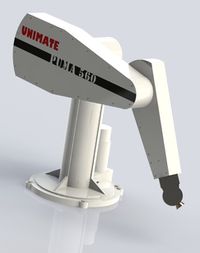Denavit-Hartenberg Convention
| ← Back: Realization of transformations | Overview: Denavit-Hartenberg Convention | Next: Types of joints → |
In the robotics field, one important aspect is the control of serial link manipulators or robotic arms, respectively. A serial link manipulator is a series of links connected with actuated joints, commonly with an end-effector attached to the last link. One of the most famous robotic arms is the Unimate Puma560, that is shown in the figure on the right.
The spacial relationship between the links of a manipulator depends on the current joint parameters and so does the transformation of the end-effector with respect to the manipulators base frame. As for example objects are to be grabbed at certain positions and kinematics are highly dependent on it, the transformation of the end-effector is of high importance for the control of a robotic arm.
The Denavit-Hartenberg convention covers methods to assign coordinate frames to the links of serial link manipulators and to describe the spatial relationship between them by four parameters. Using these methods, the transformation of the end-effector with respect to the manipulators base frame can easily be determined and used for further computations.
In the following subarticles the individual aspects of the Denavit-Hartenberg convention are treated in detail:
